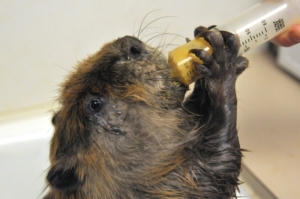
Willard Bay Beaver Baby from Ogden Standard-Examiner
Wildlife Rehabilitation Center of Northern Utah Saves Lives
If you live in Utah, you may have traveled to the Farmington Bay Bird Refuge in February to spend time with the 800-1,500 bald eagles that winter there every year. You’ve probably also heard about the West Nile virus outbreak that claimed 27 of these magnificent raptors this season. Or maybe you’ve been following the Willard Bay beavers, six animals—one adult and five young ’uns—who were badly injured during a Chevron oil spill in March 2013. All these beings spent time in the loving care of wildlife rehabilitators and veterinarians at the Wildlife Rehabilitation Center of Northern Utah (WRCNU).
But these famous cases are only a fraction of the good work WRCNU does seven days a week. Staffed with one full-time and one part-time employee, the center cares for about 2,000 animals each year, including all avian species, small mammals and reptiles. These two dedicated staff members, along with a team of veterinarians and 150 volunteers welcome sick and injured wild animals from the state’s northern borders to its center.
The center was founded in 2009. In the throes of the recession, the Ogden Nature Center had to close down its wildlife rehabilitation program. Executive Director DaLyn Erickson (WRCNU’s full-time employee) says, “We decided we couldn’t let this program go away. There is no other such program in Northern Utah. If we didn’t exist, all these animals would be euthanized. There was a great community outcry and tons of support for this.”
Currently WRCNU is hosting more than 100 patients, including five of the West Nile eagles, chipmunks, squirrels, porcupines, Golden Eagles, Western Tanagers, a Great Blue Heron and a Uintah Ground Squirrel that was picked up at a truck stop and taken to Madison, WI, to be converted to a pet—a venture that didn’t turn out well.
“She’s very cute,” says DaLyn, ”but they don’t make good pets.” Uintah Ground Squirrels hibernate for nine months out of the year. When her potential caretakers realized the squirrel was not a good fit, they contacted a local rehab facility who sent her back to Utah. “She was healthy but way too thin to survive hibernation,” says DaLyn. The center is using heat lamps to imitate summer conditions so that they can fatten her up before releasing her back to the wild.
Rising from the Ashes

Photo from 4Utah
DaLyn tells the story of a current patient, Phoenix, a golden eagle who was a baby when his nest burned in a 2012 wildfire. “He was in the nest when it burned,” she says. “It burned up around him. [A wildlife official] who had nest banded birds in the area went out after the fire to recover the band for this eagle and close the case. He was searching for the band and under a juniper tree he found the baby hiding, two weeks after the fire hit. The baby was barely alive. Every feather on his body had burned. He went through a lot and has survived. We still have him with us. He hasn’t gotten all his feathers back yet. He’s got the most fight of any bird I’ve ever worked with. He’s earned his name. He’s big and furious.”
One of the Willard Bay beavers still lives at WRCNU, but will be released as soon as an injured foot heals. After a Chevron pipeline broke and flooded Willard Bay with diesel fuel, the six beavers were the last to be rescued. They spent a week soaked in diesel fuel. DaLyn says that their fur and skin were washing off. “They were so injured you could almost see how grateful they were for what we were doing for them,” she says.
Baby Season Coming Up
As with cats and dogs, wild animals proliferate in springtime. “Once May hits, it’s sheer insanity,” says DaLyn. Last July the center hit its annual record, housing 417 animals at once. As the only full-time employee, DaLyn works seven days a week, 14-16 hours each day. It’s a heavy schedule, but the work is more than worthwhile. “I do this because someone needs to. We track what we take through our door. Consistently 90 percent of the animals we take in are with us because of human impact. We have a chance to teach people about our impact on wildlife. Every time someone walks in carrying an animal, we have the chance to educate them. They wouldn’t bring animals to us if they didn’t care. We have a huge opportunity to educate them.”
Through March, a percentage of your Hugger Mugger purchases will go to help WRCNU in its vital work. Please consider donating to WRCNU via their website or if you live in Utah, join their roster of volunteers.
